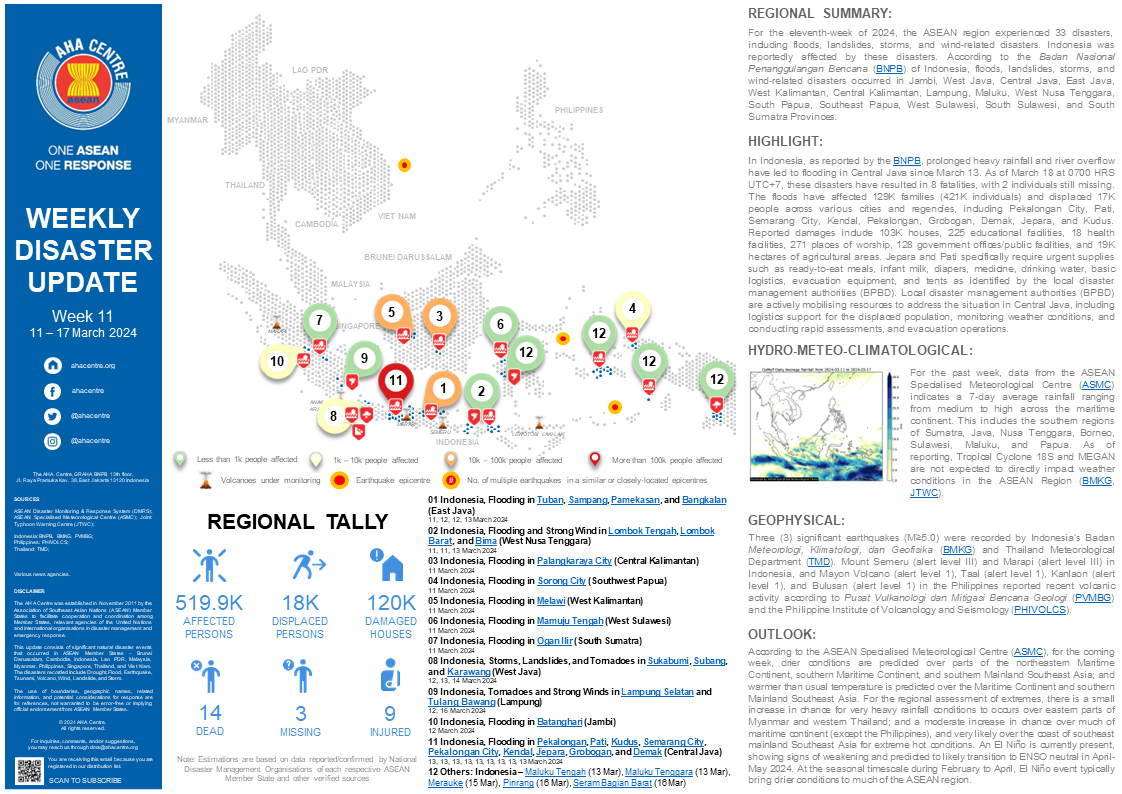
REGIONAL SUMMARY:
For the eleventh-week of 2024, the ASEAN region experienced 33 disasters, including floods, landslides, storms, and wind-related disasters. Indonesia was reportedly affected by these disasters. According to the Badan Nasional Penanggulangan Bencana (BNPB) of Indonesia, floods, landslides, storms, and wind-related disasters occurred in Jambi, West Java, Central Java, East Java, West Kalimantan, Central Kalimantan, Lampung, Maluku, West Nusa Tenggara, South Papua, Southeast Papua, West Sulawesi, South Sulawesi, and South Sumatra Provinces.
HIGHLIGHT:
In Indonesia, as reported by the BNPB, prolonged heavy rainfall and river overflow have led to flooding in Central Java since March 13. As of March 18 at 0700 HRS UTC+7, these disasters have resulted in 8 fatalities, with 2 individuals still missing. The floods have affected 129K families (421K individuals) and displaced 17K people across various cities and regencies, including Pekalongan City, Pati, Semarang City, Kendal, Pekalongan, Grobogan, Demak, Jepara, and Kudus. Reported damages include 103K houses, 225 educational facilities, 18 health facilities, 271 places of worship, 128 government offices/public facilities, and 19K hectares of agricultural areas. Jepara and Pati specifically require urgent supplies such as ready-to-eat meals, infant milk, diapers, medicine, drinking water, basic logistics, evacuation equipment, and tents as identified by the local disaster management authorities (BPBD). Local disaster management authorities (BPBD) are actively mobilising resources to address the situation in Central Java, including logistics support for the displaced population, monitoring weather conditions, and conducting rapid assessments, and evacuation operations.
HYDRO-METEO-CLIMATOLOGICAL:
For the past week, data from the ASEAN Specialised Meteorological Centre (ASMC) indicates a 7-day average rainfall ranging from medium to high across the maritime continent. This includes the southern regions of Sumatra, Java, Nusa Tenggara, Borneo, Sulawesi, Maluku, and Papua. As of reporting, Tropical Cyclone 18S and MEGAN are not expected to directly impact weather conditions in the ASEAN Region (BMKG, JTWC).
GEOPHYSICAL:
Three (3) significant earthquakes (M>5.0) were recorded by Indonesia’s Badan Meteorologi, Klimatologi, dan Geofisika (BMKG) and Thailand Meteorological Department (TMD). Mount Semeru (alert level III) and Marapi (alert level III) in Indonesia, and Mayon Volcano (alert level 1), Taal (alert level 1), Kanlaon (alert level 1), and Bulusan (alert level 1) in the Philippines reported recent volcanic activity according to Pusat Vulkanologi dan Mitigasi Bencana Geologi (PVMBG) and the Philippine Institute of Volcanology and Seismology (PHIVOLCS).
OUTLOOK:
According to the ASEAN Specialised Meteorological Centre (ASMC), for the coming week, drier conditions are predicted over parts of the northeastern Maritime Continent, southern Maritime Continent, and southern Mainland Southeast Asia; and warmer than usual temperature is predicted over the Maritime Continent and southern Mainland Southeast Asia. For the regional assessment of extremes, there is a small increase in chance for very heavy rainfall conditions to occurs over eastern parts of Myanmar and western Thailand; and a moderate increase in chance over much of maritime continent (except the Philippines), and very likely over the coast of southeast mainland Southeast Asia for extreme hot conditions. An El Niño is currently present, showing signs of weakening and predicted to likely transition to ENSO neutral in April-May 2024. At the seasonal timescale during February to April, El Niño event typically bring drier conditions to much of the ASEAN region.
Sources:
ASEAN Disaster Monitoring & Response System (DMRS); ASEAN Specialised Meteorological Centre (ASMC); Joint Typhoon Warning Centre (JTWC);
Indonesia: BNPB, BMKG, PVMBG;
Philippines: PHIVOLCS;
Thailand: TMD;
Various news agencies.







